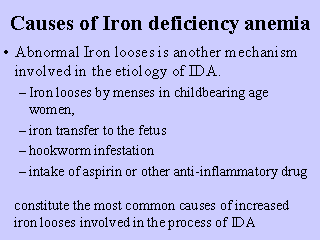|
|
|
|
front |1 |2 |3 |4 |5 |6 |7 |8 |9 |10 |11 |12 |13 |14 |15 |16 |17 |18 |19 |20 |21 |22 |23 |24 |25 |26 |27 |28 |29 |30 |31 |32 |review |
 |
b) Abnormal Iron looses is another mechanism involved in
the ethiology of IDA. Iron looses by menses in childbearing age women, iron transfer to the fetus during pregnancy, hookworm infestation or intake of aspirin or other anti-inflammatory drug constitute the most common causes of increased iron looses involved in the process of IDA. Their participation in the process of ID is different; for example hookworm infestation is observed in developing countries, or the amount of iron lost by menses vary with woman’s contraceptive practices. The loose of iron estimated in healthy adult man is approximately 1mg/day (Green et al, 1968) and additional loose of 0.5 mg/day in women (Hallberg et al. 1988). Hallberg estimated that from 1040 mg of iron needed for a pregnancy, 840 mg are lost permanently and 200 retained. Based on the amount of Iron bioavailable, diets can be divided into low (5%), intermediate (10%) and high (15%) iron bioavailable. |